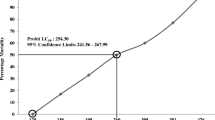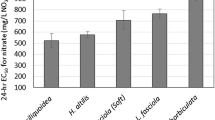Abstract
Although aquatic toxicity data exists for tungstate substances, insufficient data of high quality and relevancy are available for conducting an adequate risk assessment. Therefore, a series of acute and chronic toxicity tests with sodium tungstate (Na2WO4) were conducted on an aquatic invertebrate (Daphnia magna), green alga (Pseudokirchneriella subcapitata), and zebrafish (Danio rerio). Collectively, the data from these studies suggest that sodium tungstate exhibits a relatively low toxicity to these taxa under these test conditions. All studies were conducted in the same laboratory under good laboratory practice standards using Organisation for Economic Co-operation and Development guidelines with the same stock of test material and the same analytical methods. All results are reported as mg W/L. The following toxicity values were based on mean measured concentrations. For D. magna, the 21 day test no-observable effect concentration (NOEC) was 25.9 mg W/L, and the 48-h median effective concentration (EC50) from the acute test was >95.5 mg W/L (the highest concentration tested). The P. subcapitata test yielded an ErC50 of 31 mg W/L. A 38-day test with zebrafish resulted in an NOEC ≥5.74 mg W/L with no effects at any concentration. The 96-h LC50 from the acute test with zebrafish was >106 mg W/L. The results of the current acute study for daphnids and fish are consistent with published literature, whereas the algae results are different from previously reported values. Transformation/dissolution (T/D) studies, which were conducted according to United Nations Globally Harmonized System of Classification and Labelling of Chemicals protocol, confirmed that the WO −24 anion accounted for most of the tungsten in solution. For classification purposes, the algae ecotoxity reference value was then compared with T/D data and would not classify Na2WO4 as an aquatic toxicant under the European Union Classification, Labelling and Packaging scheme.
Similar content being viewed by others
References
American Public Health Association (1998) Methods 2320 and 2340. In: Greenburg AE, Trussell RR, Clesceri LS (eds) Standard methods for the examination of water and wastewater, 20th edn. APHA, American Water Works Association, Water Pollution Control Federation, Washington, DC
American Society for Testing and Materials (1997) Standard guide for conducting static 96 h toxicity tests with microalgae. ASTM E1218-97a
Bednar AJ, Mirecki JE, Inouye LS, Winfield LE, Larson SL, Ringelberg DB (2007) The determination of tungsten, molybdenum, and phosphorus oxyanions by high performance liquid chromatography inductively coupled plasma mass spectrometery. Talanta 72:1828–1832
CANMET-MMSL (2010) Transformation/dissolution studies on tungsten compounds, and tungsten metal. Report no. 09-005 (CR)
European Commision (EC) (2006) Regulation No 1907/2006 of the European Parliament and of the Council of 18 December 2006 concerning the Registration, Evaluation, Authorisation and Restriction of Chemicals (REACH), establishing a European Chemicals Agency, amending Directive 1999/45/EC and repealing Council Regulation (EEC) No 793/93 and Commission Regulation (EC) No 1488/94 as well as Council Directive 76/769/EEC and Commission Directives 91/155/EEC, 93/67/EEC, 93/105/EC and 2000/21/EC. Official Journal of the European Union L 396, 30.12.2006, 1–849
European Commission (EC) Regulation (2008) No 1272/2008 of the European Parliament and of the Council of 16 December 2008 on classification, labeling and packaging of substances and mixtures, amending and repealing Directives 67/548/EEC and 1999/45/EC and amending Regulation (EC) No 1907/2006. Official Journal of the European Union L 353, 31.12.2008, 1–1355
Koutsospyro A, Braida WJ, Christodoulatos C, Dermata D, Strigul NS (2006) A review of tungsten: from environmental obscurity to scrutiny. J Hazard Mater 136:1–19
Mount DI, Brungs WA (1967) A simplified dosing apparatus for fish toxicological studies. Water Res 1:21–29
Organisation for Economic Co-operation and Development (1992a) OECD guidelines for testing of chemicals. Guideline no. 203: fish, acute toxicity test
Organisation for Economic Co-operation and Development (1992b) OECD guidelines for testing of chemicals. Guideline 210: fish, early life-stage toxicity test
Organisation for Economic Co-operation and Development (1998) OECD guidelines for testing of chemicals. Guideline 211: Daphnia magna reproduction test
Organisation for Economic Co-operation and Development (2004) OECD guidelines for testing of chemicals. Guideline 202: Daphnia sp., acute immobilisation test
Organisation for Economic Co-operation and Development (2006) OECD guidelines for testing of chemicals. OECD guideline no. 201: freshwater alga and cyanobacteria, growth inhibition test. Official Journal of the European Union, 2007
Skeaff JM, Hardy DJ, King P (2008) A new approach to the hazard classification of alloys based on transformation/dissolution. Integr Environ Assess Manag 4(1):75–93
Strigul N (2010) Does speciation matter for tungsten ecotoxicology? Ecotoxicol Environ Safe 73:1099–1113
Strigul N, Galdun C, Vaccari L, Ryan T, Braida W, Christodoulatos C (2009) Influence of speciation on tungsten toxicity. Desalination 248:869–879
Strigul N, Koutsospyros A, Christodoulatos C (2010) Tungsten speciation and toxicity: acute toxicity of mono- and poly-tungstates to fish. Ecotoxicol Environ Safe 73:164–171
United Nations Globally Harmonized System of Classification and Labelling of Chemicals (2009). Second revised edition. New York and Geneva. Annex 10: Guidance on transformation/dissolution of metals and metal compounds.
Upitis V, Nollendorfa A, Pakalne D (1974) Little-investigated trace elements in Chlorella: tungsten. Vestis Lat Psr Zinat Akad 9(326):34–35
Acknowledgments
The authors are grateful for the assistance of Maureen Niemeier (ARCADIS) in compiling and formatting data as well as John Aufderheide (ABC Laboratories, Inc.), and Jim Skeaff (CANMET–MMSL) for their critical reviews of the manuscript. Funding for the research presented in this manuscript was provided by the Tungsten REACH Consortium. All studies and results were developed in support of registration of W substances in accordance with the EU legislation on Registration, Evaluation, Authorisation and Restriction of Chemicals (REACH).
Author information
Authors and Affiliations
Corresponding author
Rights and permissions
About this article
Cite this article
Clements, L.N., Lemus, R., Butler, A.D. et al. Acute and Chronic Effects of Sodium Tungstate on an Aquatic Invertebrate (Daphnia magna), Green Alga (Pseudokirchneriella subcapitata), and Zebrafish (Danio rerio). Arch Environ Contam Toxicol 63, 391–399 (2012). https://doi.org/10.1007/s00244-012-9774-3
Received:
Accepted:
Published:
Issue Date:
DOI: https://doi.org/10.1007/s00244-012-9774-3




